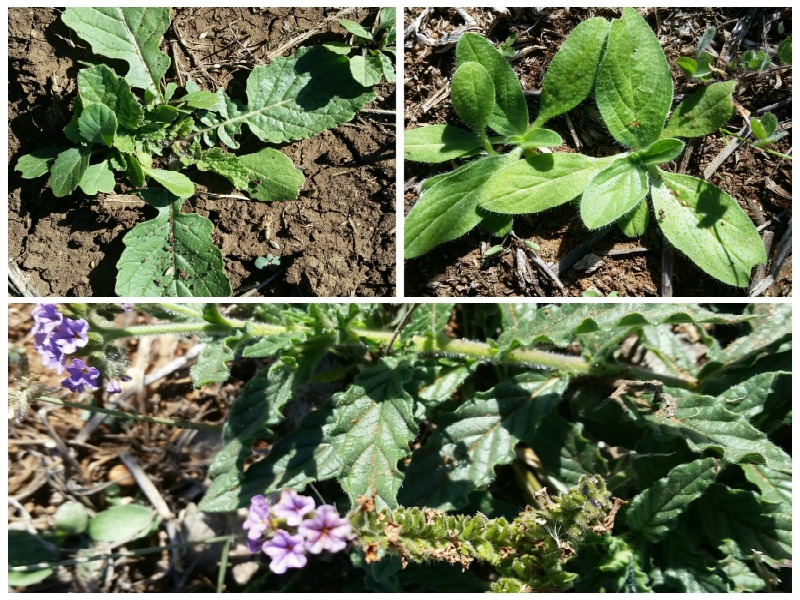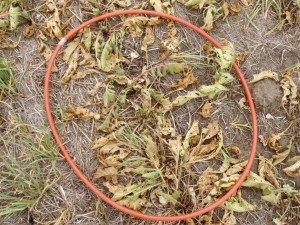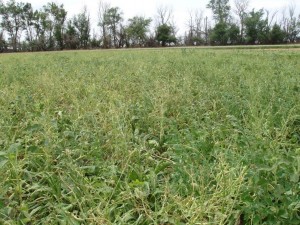When we have an influx of weeds, or a specific weed, we can curse “the damn” things or we can stop, think and use them as a lesson and/or a tool. Weeds can tell us things about soil condition, ground cover and what might be an appropriate action to repair and bring a soil back into balance. Agriculture needs to consider different ways to manage weeds because current conventional systems have a finite lifetime of success. Consider the application rates of herbicides used in crop production systems today when compared with 20 years ago. There have been really significant rate increases – and it is not just rate increases – we now have double knock strategies that further increase the use of pesticides. Sure, the double knock strategies delay the build-up of resistant weeds, but this is a delay tactic, not a solution. We need to explore other options now.
Granted, weed control is probably one of the more challenging aspects of a reduced pesticide input system (at least in cropping), but this is no reason not to try. As I mentioned above, the herbicide dominated system has a limited lifetime.
What can weeds tell us?
Weeds can serve some purpose to us, but it’s up to us to determine how to best make advantage of them practically in our farming and grazing systems, without having them overrun our production. [private]In the case of livestock we know from the wonderful work that Professor Fred Provenza has done that weeds can be an extremely useful addition to the diet of animals – providing the diversity in compounds needed for optimal health of animals, but we don’t want one species to overrun our pastures and there is a problem if that occurs. So how can we use weeds to our advantage?
Groundcover
Weeds, quite obviously fill a void in groundcover (particularly annual weeds), which help prevent erosion. In doing this they also create diversity in the paddock and to the soil life that they support. If we are getting many weeds in a grazing situation however, we need to ask ourselves what we have done to create the bare ground that the weeds then want to fill. Grazing management would be a good place to start examining.
Clearly in a monoculture cropping situation, there is much opportunity for weeds to establish into areas of low ground cover – both in crop and in the fallow period. Weeds in this case are just doing what comes naturally and filling a void.
Soil condition
Certain weeds prefer or can cope with different growing conditions. We know that different plants will thrive in different pH soils, some plants will be found in compacted areas, while others will do well in a low nutrition soil that others would not survive in. Sorrel favours acidic soils; docks favour wet soils and dandelion in a neutral soil.1 Patterson’s Curse is often present where a calcium or copper deficiency is present,2 and so on. Joseph A. Cocannouer wrote back in 1950 in Weeds – Guardians of the Soil, of the role that weeds play, and this book will tell you more specifics of what individual species may be indicating.
Cocannouer also states that “weeds bring minerals, especially those which have been depleted, up from the subsoil to the topsoil and make them available to crops. This is particularly important with regard to trace elements”.3 There are suggestions that the weeds that colonise an area are actually the plants necessary for solving the deficiency problem in that soil. It is reported likewise that when a hardpan is present, weeds will come that have a solid taproot that will push deep into the soil and break up the compaction. While I am not aware of scientific testing of this idea, it is certainly the case that some weeds and/or plants have higher concentrations of certain minerals – maybe they push deeper into the soil to access these, maybe they support different soil microbes that in turn make these minerals available to the plant, likely a combination of things and even something we are not understanding. Such plants are often referred to as dynamic accumulators.
So, we can research the sorts of environments favoured by the weeds that we see growing on our farms to learn more about our soils.
Further, we can amend and alter our soils to get the soil outcomes that then discourage the abundance of that weed. In a cropping system that builds and balances soils, the weed spectrum will change as the soil changes.
Weeds Healing Our Soils
This idea that the weeds that grow is supported by the outcomes of nature, in that when a paddock is left to its own devices, or grazed in an appropriate manner, a succession of plants will occur. “Ecological succession” is the observed process of change in the species structure of an ecological community over time”.4 An example of this is an annual cropping paddock let go to nature. At first it will be colonised by annual weeds, which will perhaps be replaced by other annual weeds but will eventually be colonised by perennial species. We have seen this ourselves (which I have described previously in Converting Cropping Country to Pasture) on sorghum cropping country, that we let go to naturally come back to pasture. The first year we had the best crop of the weed fleabane you could imagine! Three years on and now however we have native perennial grasses. Did the fleabane do some sort of ‘healing’ of the soil, which allowed the succession to higher order plants? It has been described that “The ‘engine’ of succession, the cause of ecosystem change, is the impact that established species have upon their own environments”. This could vary from nutrient changes to soil structural changes, to soil biological changes – and most likely many of these together.
Weeds Leading Our Practices
Clearly, what grows well in your soil is what grows well in your soil. Yes, I know stating the obvious, but sometimes we overlook the obvious. Taking our cues from the weeds can be helpful. So, if turnip weed is largely present in one paddock, then including a brassica species in the mix if considering either a cover crop or in a mixed species pasture crop in that paddock is probably a good idea. You may remember Gabe Brown (cover cropper from North Dakota in The ‘New’ Cover Cropping) always says that the first thing you do when thinking of planting a cover crop is to identify your resource limitation. So, the weeds in your paddock may well be a good indication of your resource limitation.
There is much circumstantial evidence of crops doing better in areas where a particular weed is growing. While in many monoculture crops this is not the case – there are obviously combinations that work well together. This is where the idea of companion planting in our gardens comes from which is also being practiced by some growers who are planting two crops together – like corn with a legume. Tap rooted plants can bring both nutrients and moisture up from deep below that it is believed can then be shared among more shallow rooted plants through soil fungi – specifically mycorrhizae. This may be some of the reasoning behind why mixed species crops – be they cover or cash, can actually perform better in dry times than a single species crop. This can also be relevant to diverse pastures versus a single species pasture or fodder crop.
Remember these images of single species cover crops versus mixed species from the above mentioned blog. (Same planting date, same paddock history etc). An astounding difference!
Managing Weeds
In a grazing sense, annual weed control is highly related to groundcover and grazing management. Some perennial weeds do however prove more challenging and there needs to be more conscious thought put into the grazing approach.
In a cropping sense, weeds can cause one of the biggest challenges for farmers who are wondering how they can move away from their reliance on ever increasing pesticide use.
Changing the direction of planting to an east west direction to take advantage of the shading from plants between the rows for winter crop can have significant impact on weed numbers in the further latitudes. NSW DPI trials have identified 40% reductions in weed biomass from changing sowing direction. Western Australia has also done trials over many years, identifying similar results of 30-50% weed biomass reduction.5 Sowing rate and competitiveness of the crop should also be considered.
Choosing cover cropping instead of fallows; growing plants in what would otherwise be a herbicide control period for weeds, and using the matt of these crops laid down to plant into which give a mulch of matter to prevent weed germination are other options to pesticides. As I regularly state, it is time to start experimenting with these practices in order to tailor them to our area and soils, because I’m pretty confident in saying that the longevity of chemical weed control is just not there.
We can rely on others to come up with a brand new plan for us, or we can become somewhat more accountable in our own farming systems and get to understand the cause, rather than asking for a bigger band aid. (You may like to refer to Accountability is Powerful!)
What are your thoughts on the longevity of the current reliance on herbicides in our cropping systems?
What are you doing in your grazing and cropping systems with regard to weeds?
Have you had any wins or challenges with different techniques? Please share – we’d love to hear.
References
- Perry, Leonard P. What Weeds Can Tell You. University of Vermont Extension, Department of Plant and Soil Science. http://pss.uvm.edu/ppp/articles/weedstell.html 14th May 2015
- Schonbeck, Mark. An Ecological Understanding of Weeds (Aug 2013). eXtension. http://www.extension.org/pages/18529/an-ecological-understanding-of-weeds#.VVP4l7mqqko 14th May 2015.
- Cocannoeur, J. (1950) Weeds – Guardians of the Soil. http://vanveenorganics.com/ebooks/Weeds%20guardians%20of%20the%20Soil%20%283%29.pdf 14th May 2015.
- Ecological Succession. The Virtual Nature Trail at Penn State New Kensington. (July 2009) Pennsylvania State University. http://www.psu.edu/dept/nkbiology/naturetrail/succession.htm 14th May 2015.
- Dixon, Tom. (May 2014) Row Spacing a Tactical Weed Suppressor. GRDC http://grdc.com.au/Media-Centre/Ground-Cover/GC110/Row-spacings-a-tactical-weed-suppressor



